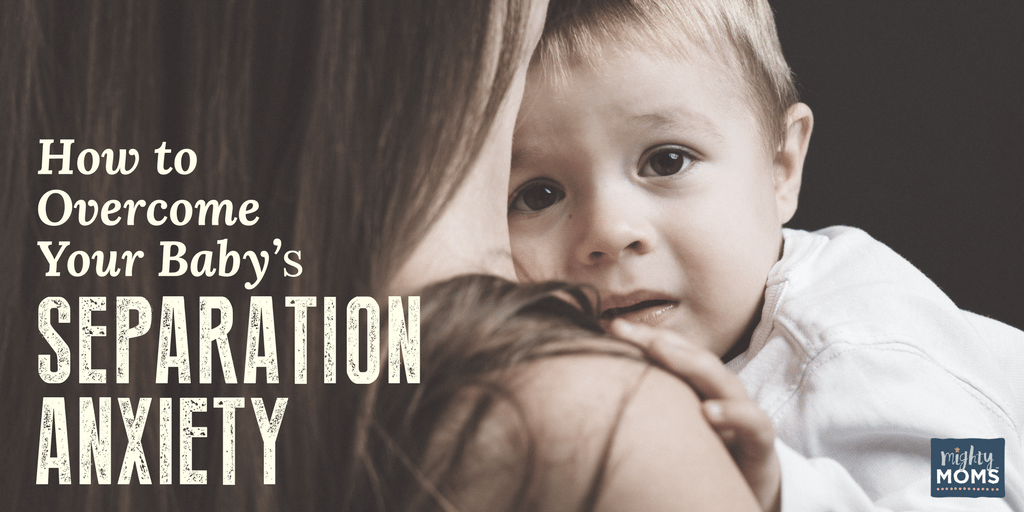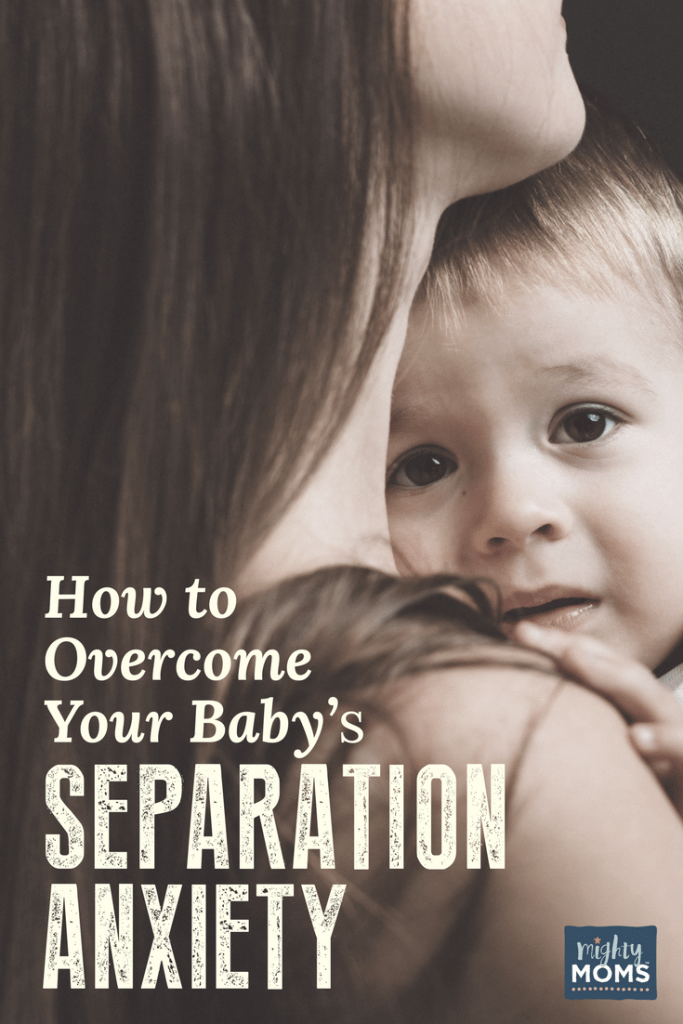On a scale from 1 to 10, let’s find out where your child lands on the “Separation Anxiety in Babies” scale.
Is he a one?
Glad you exist, Mom, but I’m totally rocking these toys over here.
I’ll let you know when I’m hungry, otherwise leave me be.
Or is he a ten?
Must. Grip. Shirt. Is she trying to move away?
SOUND THE ALERT!
*waaaaaaaaaaaaaail*
Today we’re going to dig into the deep dark scary world of “separation anxiety”.
We’ll go over symptoms.
We’ll announce cures.
We may even chuckle once or twice. (No promises. I know how tired you are.)
Is Your Baby Dealing With
Separation Anxiety?
If it isn’t the million dollar question of the day…
I swear, 98% of parenting a baby can seem like random guessing. The day I invent a “baby translator” is the day that I purchase Ireland and start a utopia. #livinthedream
Until that day happens (keep praying, my Irish friends!), it’s my job to inform your guesses so more of them land on a BINGO.
So, here goes.
The Non-Helpful Age Clue
I say this is non-helpful because, really, every baby’s different.
I’ve worked with babies as young as 4-5 months, who were waking up at night not because they were hungry, but because mom had just returned to work and they needed the extra cuddles and reassurance.
That said, though, the typical “hot spots” in terms of age are around 6-8 months, 12 months, and 18 months.
Also remember, separation anxiety doesn’t start and stop like a car down the road. It flows. There are good days and bad days, high weeks and low…you get the picture.
The More-Helpful Observance Clue
Think back to the last week and ask yourself…
- Does he seem more clingy than usual?
- Does he cry when you step out of sight for a minute?
- Does he seem to prefer one parent over another?
- Does he seem anxious at naptime and bedtime at being alone?
- Does he seem to instantly improve as soon as he sees a parent’s face?
3 Strategies to Overcome
Separation Anxiety in Your Baby
The emotion at the heart of your baby’s separation anxiety is FEAR. (And THAT, my friends, is why you pay me the big bucks. #smarttalking)
So it makes sense that the best strategies that help separation anxiety are centered about building confidence.
Here are three ways to help him cheerfully wave those chubby arms goodbye.
Separation Anxiety Strategy #1: Make Sure He’s Not Overtired
As some of our Sleep Session clients know, the brain secretes the hormone melatonin when it’s getting ready to head to Sleepyville.
Part of the reason it’s so important to create a predictable bedtime routine is to give his little brain the clue to start making melatonin. It’s like the little white flag of sleeping surrender.
If you miss your child’s sleep window and he gets overtired, the brain will start secreting a hormone called cortisol instead. This is a stress hormone. If your baby’s brain is already swimming in cortisol and you decide to leave him….
*nuclear explosion*
Learn how to set up a routine throughout the day that will catch those sleepy windows and help him stay as rested as possible. It will work wonders on his ability to exist without being tied firmly to your hip.
Separation Anxiety Strategy #2: Introduce Him to Mr. Lovey
Mr. Lovey is a small blanket or stuffed animal that can sit in as a substitute to you. (My older girls have “Mimi” blankets, and my youngest has “Lamby”.)
Mr. Lovey cuddles with him when you’re feeding, rocking, reading books, or in the car. Mr. Lovey even plays with him (through your capable hands of course). Eventually when he holds and looks at Mr. Lovey, he smells and thinks of you.
In other words, even when you’re not with him, Mr. Lovey is, and since Mr. Lovey equals YOU….you are always with him.
*mind blown*
If you’re still not convinced, check out For the Sake of Your Sleep: Why Your Baby Needs a Lovey.
Separation Anxiety Strategy #3: Practice Quiet Times
As an introvert, quiet times are a necessity to keep me on the “happy to have children” side of life. Without them, I quickly degenerate into the Hulk: lots of grunts and roars.
Perhaps my BEST piece of advice in overcoming separation anxiety is to teach your child to build his self-confidence through Quiet Times.
Here’s how it works:
Step One: Put him in the crib with some toys and a few beloved board books. Play with him while he’s in the crib. Do this for 10 minutes a couple times a day for 3 days.
Step Two: Put him in the crib with some toys and board books. Sit in the room and read or whatever, while he plays for 10 minutes a couple times a day for 3 days.
Step Three: Repeat Step Two, but after 2-3 minutes when he seems engaged, leave the room for a few minutes. If he cries, quickly return with smiles and sit down. Repeat until you can leave for a few minutes. Keep letting that time get longer and longer.
Step Four: Put him down for his quiet time and leave the room. Let him play alone (perhaps with music playing) for 30-45 minutes.
The goal here is to teach him how to be independently happy.
The Quiet Time technique is also great if your baby has a negative association with his nursery. If he cries every time you walk in the room, how will he ever learn to sleep there? Help him see the nursery is a happy place he enjoys spending time in and your crib-training will go much easier.
3 Things You Should Never Do
When Handling Separation Anxiety
I’ve shared the “shoulds,” but there are three “should-nots” you should be aware of. (Catch what I did there? hehe)
Separation Anxiety No-No #1: Never Sneak Away
I know it’s tempting, but emotionally the “Sneak Away” costs more than it earns. Sneaking away just highlights to your child that he has to be touching or looking at you AT. ALL. TIMES. (And you thought he was clingy now…)
Offer a quick hug and a confident goodbye instead. As hard as it is for him to see you leave, it’s a vital step in learning that you DO come back!
Separation Anxiety No-No #2: Never Act Like You’re Sad to Leave…Even If You Are
Your baby is as emotionally tuned into you as Kim Kardashian is to a camera. They know…
If you are tearful and stressed when you leave, he will mimic those emotions while you’re gone.
Even if you don’t feel happy to leave him behind, go with the acting confidence of an Emmy-Winning Actress. It will make it easier on you both.
Separation Anxiety No-No #3: Never Do the Hand-Off Transfer
If your child is doing the whole “rip mom’s shirt off at daycare” thing when you’re trying to leave, don’t have a caregiver pry his fingers away like a convict’s last glimpse of the sun. Who wants to head off to work with that traumatic image in the front of your mind all day? Ugh.
Instead, put your little man on the ground and kneel beside him with a toy or a book or something, letting the caregiver sit beside him. Once he’s interested in something, give him a smile, pat, and a kiss on the head and say “Goodbye for now, Little Champ!” (or whatever) and let the caregiver step in.
Yes, he’ll probably wail the house down, but the caregiver has got a BUNCH of distracting toys sitting right there in front of him. Half the battle is already won!
I guarantee he’ll calm down a lot faster this way. (And you can leave with the pleasant image of him surrounded by activities and games instead!)
Does your infant struggle with separation anxiety? How have you handled it?
Have You Read These Yet?
- Everything a New Mama Warrior Needs To Know About Baby Care
- How to Choose the Best Baby Formula for Your Superbaby
- Clean Out Your Cauldron: The 4 Best Baby Formulas for Acid Reflux
- The Mobster’s Guide to Switching Baby Formula
- 3 Reasons Why American Parents are Loving European Baby Formulas
We ♥ honesty! This post contains affiliate links that provide extra money for our mutual coffee habits addictions. Click here to learn more. As an Amazon Associate I earn from qualifying purchases.


